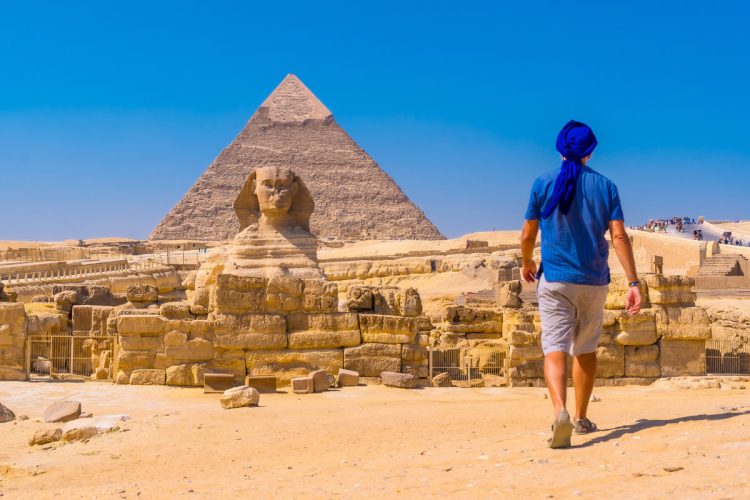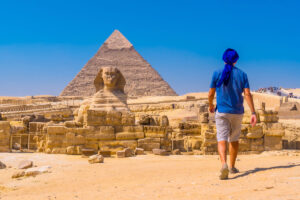Planning Your Itinerary for a Memorable Trip
A Journey through Time in Cairo
- The Egyptian Museum: Home to the world’s most extensive collection of pharaonic antiquities, it’s a treasure trove for history enthusiasts.
- Khan El Khalili Bazaar: A vibrant market where you can experience the colors, scents, tastes, and sounds of Cairo.
- The Pyramids of Giza: The iconic pyramids and Sphinx are architectural marvels that stand as testaments to Egypt’s ancient civilization.
- Old Cairo: This area houses various sites of cultural and historical significance, including the Hanging Church, the Ben Ezra Synagogue, and the Coptic Museum.
- The Citadel of Saladin: This Islamic-era fortress offers panoramic views of the city and houses several notable mosques and museums.
- Al-Azhar Park: One of Cairo’s largest parks, it offers stunning views of the city’s skyline, including several mosques and minarets.
- Tahrir Square: Known as the heart of modern downtown Cairo, it’s been the site of numerous major protests and demonstrations throughout history.
- The Nile Corniche: A walk along the Nile is a great way to experience the city’s modern side, with views of Cairo’s skyline and the river’s feluccas (traditional wooden sailing boats).
- Al-Azhar Mosque: One of Cairo’s earliest surviving mosques, it’s a beautiful example of Islamic architecture and also houses one of the world’s oldest universities.
- Sultan Hassan Mosque and Madrasa: Considered one of the masterpieces of Mamluk architecture, this mosque-madrasa complex is a must-see.
Remember, Cairo is a city that is best experienced rather than just seen. Take the time to immerse yourself in the city’s rich history, vibrant culture, and bustling street life to truly appreciate what it has to offer.
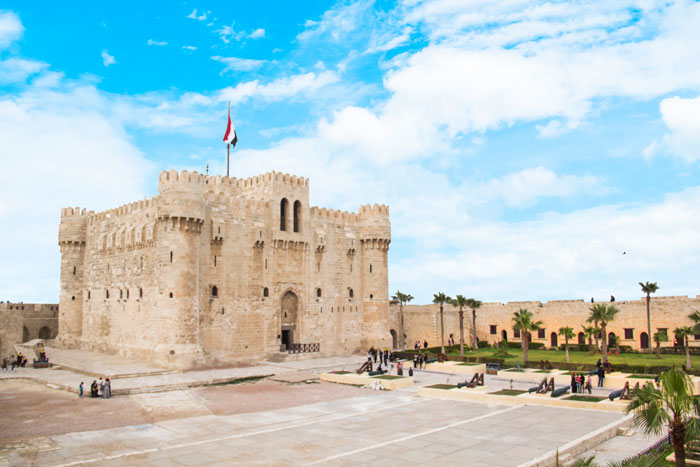
Explore Alexandria’s Rich History
- Qaitbay Citadel: This 15th-century defensive fortress located on the Mediterranean coast is built on the site of the ancient Lighthouse of Alexandria, one of the Seven Wonders of the Ancient World.
- The Catacombs of Kom El Shoqafa: One of the Seven Wonders of the Middle Ages, this multi-level underground burial site contains tombs, statues, and archaeological artifacts dating back to the 2nd century AD.
- Pompey’s Pillar: This Roman triumphal column is one of the largest monolithic columns ever erected. It was constructed in honor of Emperor Diocletian at the end of the 4th century.
- Bibliotheca Alexandrina: A modern architectural marvel, this vast library is dedicated to recapturing the spirit of the ancient Library of Alexandria. It houses millions of books and an antiquities museum.
- Montaza Palace Gardens: This complex includes beautiful gardens and two palaces, built during the 19th and 20th centuries, offering a glimpse into the luxurious life of the royal family.
- Roman Amphitheatre: Discovered in the 1960s, this well-preserved Roman-era amphitheatre has marble terraces and galleries that once seated up to 800 spectators.
- Alexandria National Museum: Housed in a restored Italianate mansion, the museum’s collections chronicle the history of Alexandria from ancient times through the modern era.
- The Jewish Cemetery of Alexandria: This cemetery provides insight into the multicultural history of Alexandria, reflecting its Greek, Italian, French and Jewish influences.
- El Alamein War Museum and Cemetery: Located west of Alexandria, El Alamein is known for the major World War II battle fought there. The museum and cemetery commemorate the soldiers from various countries who fought and died in this battle.
Visiting these sites will provide a comprehensive overview of Alexandria’s rich and diverse history, from ancient times through the modern era.
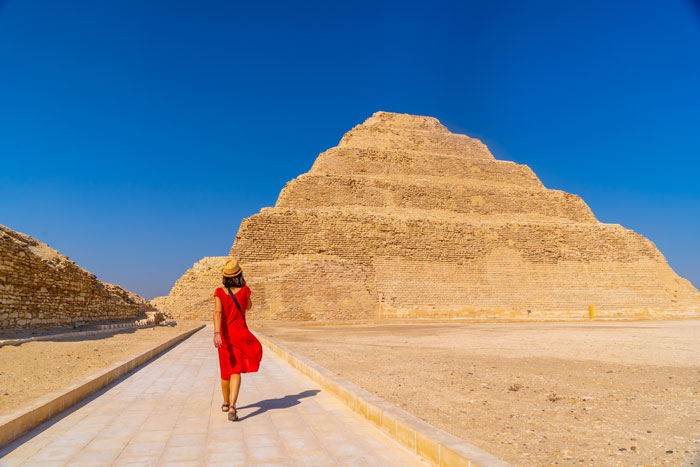
Journey to the Step Pyramid at Saqqara
- Step Pyramid of Djoser: Also known as the Step Pyramid, it’s considered the earliest colossal stone building and earliest large-scale cut-stone construction. It was built during the 27th century BCE for the burial of Pharaoh Djoser by his vizier, Imhotep.
- Imhotep Museum: Located near the Step Pyramid, this museum houses artifacts from the Saqqara area, including a statue of Djoser found in a nearby tomb.
- Serapeum of Saqqara: An ancient burial place of the Apis bulls, sacred to the god Ptah. The underground galleries date back to the reign of Amenhotep III.
- Mastaba of Ti: A highly decorated tomb belonging to Ti, a high-ranking official in the Fifth and Sixth Dynasties.
- Tomb of Mereruka: The largest tomb at Saqqara, this area contains 33 rooms with well-preserved decorations, and statues of Mereruka and his family.
- Pyramid of Teti: The pyramid complex of the Sixth Dynasty pharaoh Teti has been open to the public since 2019. It includes the pyramid, a mortuary temple, and a pyramid town.
- Pyramid of Userkaf: Built by Pharaoh Userkaf, founder of the Fifth Dynasty, this pyramid forms a key part of his funeral complex.
- Pyramid of Unas: The pyramid of Pharaoh Unas of the Fifth Dynasty is significant for the Pyramid Texts inscribed in the burial chamber, the oldest known religious texts in the world.
These sites offer a wonderful opportunity to explore the evolution of pyramid construction and the funerary practices of ancient Egypt.
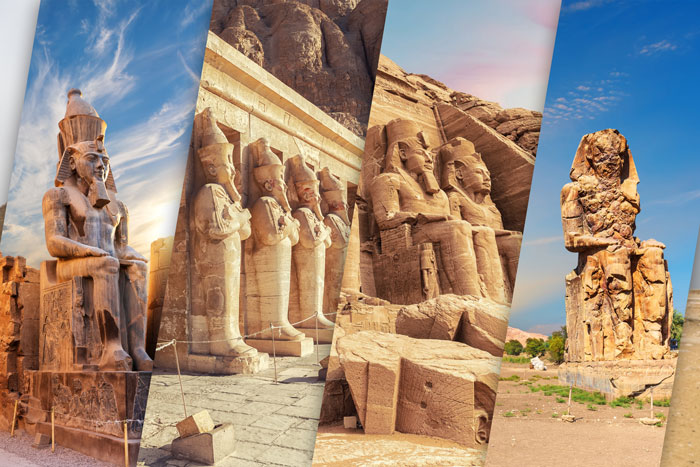
Discover the Mysteries of Luxor and Aswan
- Valley of the Kings (Luxor): This ancient burial site of New Kingdom Pharaohs is famous for its well-preserved tombs filled with colorful hieroglyphics.
- Karnak Temple (Luxor): The largest religious building ever constructed, the Karnak temple complex was built over more than 2,000 years by various Egyptian pharaohs.
- Luxor Temple (Luxor): An impressive ancient Egyptian temple complex located on the east bank of the Nile River.
- Temple of Kom Ombo (Aswan): This unique double temple dedicated to the crocodile god Sobek and the falcon-headed god Horus is known for its beautifully preserved hieroglyphic reliefs.
- Philae Temple (Aswan): This beautiful temple dedicated to the goddess Isis is located on an island in the Nile River.
- Abu Simbel (Aswan): This site, located near Sudan, houses two temples built by Ramesses II, famous for their colossal statues.
- Unfinished Obelisk (Aswan): Located in an ancient stone quarry, the obelisk provides insight into stone-working techniques used during the height of Ancient Egypt.
- The Tombs of the Nobles (Luxor): This collection of private tombs provides a glimpse into the daily life and customs of ancient Theban nobility.
- Colossi of Memnon (Luxor): These two massive stone statues of Pharaoh Amenhotep III have stood in the Theban necropolis for more than 3,400 years.
- Aswan High Dam (Aswan): A modern feat of engineering, the High Dam created Lake Nasser, the world’s largest artificial lake, and helped control the flooding of the Nile.
Each of these sites offers a unique perspective on ancient Egyptian civilization and culture, making Luxor and Aswan must-visit destinations for any history enthusiast or adventure seeker.
General guidelines or restrictions you should be aware of when visiting historical and attraction sites in Egypt:
- Respect Dress Code: Egypt is a predominantly Muslim country, and visitors should respect local customs and traditions. Dress modestly, particularly when visiting religious sites or rural areas. Women should cover their shoulders and knees.
- Photography Restrictions: Not all sites allow photography, especially inside tombs or museums. Flash photography is usually prohibited to preserve ancient artifacts and wall paintings. Always check for signs or ask officials if photography is allowed.
- No Touching Artifacts: Touching ancient artifacts, including wall carvings, is strictly prohibited to preserve these priceless items for future generations.
- Guided Tours: Some sites, such as the Valley of the Kings, require visitors to be accompanied by a licensed guide. It’s best to check beforehand.
- Entry Fees: Most historical sites charge an entry fee. Some also charge additional fees for photography or for entry into certain areas.
- Avoid Littering: Leave no trace behind to help maintain the cleanliness and integrity of these important sites.
- Stay on Marked Paths: To prevent damage to unexcavated areas, visitors should stay on marked paths at all times.
- Beware of Scams: Be wary of unofficial guides or vendors who may approach you at popular tourist sites.
- Respect Local Customs: At religious sites, be quiet and respectful. Remove your shoes when entering mosques.
- Stay Hydrated: Egypt’s climate can be hot, especially in the summer. Carry water with you during your visits.
Remember, these guidelines can vary from site to site, so it’s always a good idea to research specific places before you visit. The goal is to ensure the preservation of these historical sites for future generations while providing a meaningful experience for visitors.



